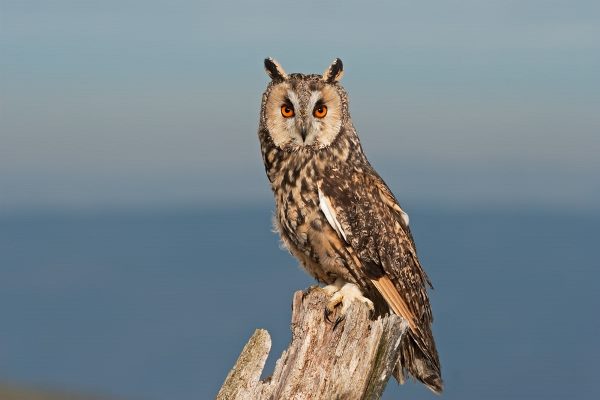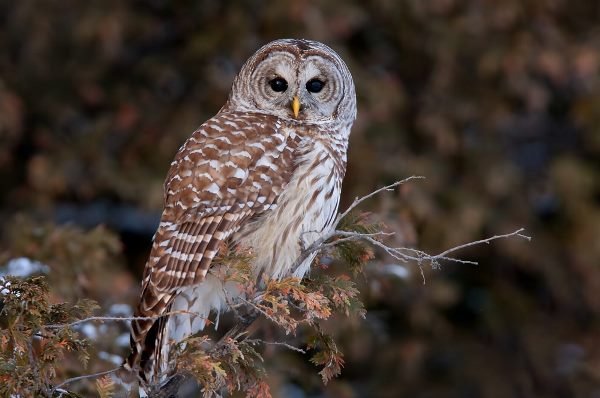West Virginia is small and it doesn’t have the dramatic variation in range that some of the surrounding states do. You won’t find drastic changes in the environment from one end of the state to the other. But despite that, what you will find is seven species of owls (with one species that may come and visit every few decades).
The state of West Virginia offers up rugged Appalachian hills and peaks, and owls love it. You can find daytime hunters and nighttime hunters all within the narrow West Virginia borders. No matter where you go, you have the opportunity to see owls.
That said, leave the city and head out to the Green Bottom Wildlife Management Area or into Beech Fork State Park and you’re sure to spot one of these stunning raptors.
Here is the list of owls in West Virginia:
- Northern Saw-Whet Owl
- Short-Eared Owl
- Long-Eared Owl
- Great Horned Owl
- Barn Owl
- Snowy Owl
- Barred Owl
- Eastern Screech Owl
8 Types of Owls in West Virginia
1. Northern Saw-Whet Owl

- Scientific name: Aegolius acadicus
- Size: 7.1-8.3 inches long
- Weight: 2.5-5.3 ounces
- Wingspan: 16.5-19 inches
Northern saw-whet owls are petite, about the size of a robin, with a mottled brown and white body. They have big yellow eyes and a heart-shaped face with a small, white V-mark between their eyes.
They are difficult to see, especially because they hunt at night for their favorite food, which is deer mice. But if you listen for their shrill call, you’ll know they’re nearby. During the day, they nest in cavities in trees at about eye height, so you might see them if you look carefully. Don’t disturb the sleeping birds, though!
They only live in forests, particularly mature forests, so don’t look for them in open areas or cities. They migrate long distances to breed. They eat small rodents like mice and shrews. They’ll also eat birds like chickadees, juncos, waxwings, and sparrows.
They live across the US, with scarce breeding populations in the South and permanent populations in the northern part of the country and throughout the Rocky Mountains and western Coastal ranges. Nonbreeding populations exist across the rest of the country.
The northern saw-whet owl lives in West Virginia during the nonbreeding, winter season.
2. Short-Eared Owl

- Scientific name: Asio flammeus
- Size: 13.4-17 inches long
- Weight: 7.3-16.9 ounces
- Wingspan: 33.5-40.5 inches
You’re right if you guessed that these owls have short ear tufts. Owls have ear tufts to help direct sound to their ears, enabling them to hunt and hear potential predators. Short-eared owls have ear tufts, but they’re small, like little horns.
They’re distinctive owls because they have brown and white mottling edged in black bars. The face is cream with dark black outlines around the yellow eyes.
Their distinctive appearance makes it easier to spot them, but the fact that they are active during the day makes it even easier to see them. They even have a distinct, moth-like flight pattern that makes identification even simpler.
Unlike many owls, they don’t prefer wooded areas. They like open fields and grasslands, where they sit on the ground and watch and listen for prey to catch. Then, they fly up and dive down to catch their meal, which may include rats, mice, lemmings, rabbits, shrews, and bats. They even nest in the ground.
Short-eared owls live in West Virginia only during the winter.
3. Long-Eared Owl

- Scientific name: Asio otus
- Size: 13.8-15.8 inches long
- Weight: 7.8-15.3 ounces
- Wingspan: 35.5-39.5 inches
Long-eared owls have surprisingly long ear tufts, which is how they got their name. The tufts are black with bits of buff or orange. They have two white lines between their yellow eyes.
They’re slender with mottled brown bodies. These nocturnal birds roots in trees and hunt in grasslands or open country.
You can often identify them by their hoots, squeals, and barks. They are quite vocal. They usually only migrate at night, but they can fly exceptionally long distances. Researchers have identified birds that have traveled from Canada to Mexico in a single year.
Those who live in or are visiting West Virginia should look for this owl during the winter across the state. Just be aware that they’re rare and hard to find.
These distinctive owls eat animals like rodents, mice, voles, and gophers, so keep an eye out for them where these rodents are abundant.
4. Great Horned Owl

- Scientific name: Bubo virginianus
- Size: 20 inches long
- Weight: 32-88 ounces
- Wingspan: 40-57 inches
Most people recognize the great horned owl thanks to its appearance in movies like the Harry Potter franchise and its characteristic hoot. These massive owls can weigh up to five-and-a-half pounds. They have massive claws, and they’re strong fliers, which enables them to take down fierce prey like ospreys and falcons.
Once they clench their claws around something, it takes 28 pounds of force to pry them back apart.
These birds live in every part of North America, from Mexico to the northern parts of Alaska. It’s one of the most common owls and makes itself home in deserts, mountains, forests, and prairies. The great horned owl is just at home in the cities of West Virginia as it is in the suburbs and wilderness areas.
All this means that you have a good chance of being able to see one. You can find it anywhere in West Virginia.
Look for the giant bird with yellow eyes and long tufts of hairs near its ears. They can be gray or cinnamon with barring over a cream or light gray body.
If you were wondering, they can’t really move their heads 360 degrees, despite what you might have heard. They can swivel their head over 180 degrees, though, giving the illusion that they’re turning their head completely around. These birds can’t move their eyes from side to side, so they move their heads back and forth instead.
This amazing ability to move its head this far enables it to hunt its favorite meals, such as rodents, frogs, and raptors like osprey, falcons, and other owls.
5. Barn Owl

- Scientific name: Tyto alba
- Size: 12.5-16 inches long
- Weight: 14-24.7 ounces
- Wingspan: 40-50 inches
The barn owl got its name because it likes to live in abandoned barns and other buildings in rural areas. They’ll also nest in the cavities of trees. They hunt by soaring across open areas and listening for prey. As you might guess, they have excellent hearing.
You can tell it’s a barn owl by its distinct face. They have pure white, heart-shaped faces with large, dark eyes. Their wings and back are gray, golden, or cinnamon and somewhat mottled. The undersides of their wings are white, as is their chest, which means they look all-white from underneath when they’re flying. They don’t have any ear tufts as the great horned owl does.
Young barn owls will fly far away from where they were hatched to find their own territory, but once they find a spot they like, they stay there for life. Once they find their home, they hunt for their main sources of food, which are small mammals such as rats, lemmings, voles, and mice. They’ll also eat bats, small birds, and rabbits.
You can find barn owls across the US and Mexico except in a few parts of the central northern states like North Dakota. The owl lives in West Virginia all year long, but it is considered endangered in the state.
6. Snowy Owl

- Scientific name: Bubo scandiacus
- Size: 20.5-28 inches long
- Weight: 56.5-104 ounces
- Wingspan: 49.5-57 inches
Snowy owls are striking birds. The males are mostly white with bright, cat-like yellow eyes. The females and immature birds have dark brown or black spots. The males become whiter as they age.
Snowy owls live in the Arctic Circle, where they hunt for mammals such as lemming and ptarmigans during the long summer days. They travel south to Canada, Alaska, and the very northern parts of the US during the winter months.
Most of the time, you can see them sitting on the ground near their hunting areas. They’ll also perch on power or telephone poles, fences, hay bales, and abandoned structures. They fly low to the ground as they scan the tundra or fields where they hunt.
In West Virginia, you may rarely see these birds when the food in their normal range is scarce. They eat things like seabirds, mice, hares, and lemmings. They’re rarely spotted in warmer regions of the US, but it’s not impossible. The MetroNews in West Virginia reported that one was spotted in 2013 in Preston County.
7. Barred Owl

- Scientific name: Strix varia
- Size: 17-20 inches long
- Weight: 16.6-37 ounces
- Wingspan: 39-43 inches
The barred owl is similar in length to the great horned owl, but they weigh much less. They are mottled brown and white with distinct bars across their entire body. The bars on the breasts are vertical and horizontal on the rest of their bodies.
These aren’t noisy birds. They generally keep quiet, though you can sometimes hear them call out during the day.
Barred owls stick to forested areas, whether that’s the swamp or high up a mountain. You won’t find them in cities or prairies. They live across the entire eastern US and up into Canada. In recent decades, the birds have expanded their range, and now there are also populations in the Pacific Northwest. They don’t migrate during their lives. They stick to one place, making their home in trees.
However, if they can’t find food, they will travel long distances to hunt their prey, which includes a wide range of critters, like mammals, small birds, reptiles, and insects.
Great horned owls hunt the barred owl, while the barred owl is pushing the endangered spotted owl out of its territory.
Barred owls live in West Virginia all year long.
8. Eastern Screech Owl

- Scientific name: Megascops asio
- Size: 6.3-9.8 inches long
- Weight: 4.3-8.6 ounces
- Wingspan: 18.9-24.0 inches
The eastern screech owl is related to the western screech owl, as you might expect. This owl lives on the east side of the Rocky Mountains, with a little overlap in the Rocky Mountains between their western cousin.
In West Virginia, you can find them across all parts of the state all year long.
Eastern screech owls are excellent hiders. Their gray or reddish-brown mottling makes them blend right into the bark of the trees where they like to perch and nest. In fact, you might not even notice them until you see their bright yellow eyes shining.
They have distinct ear tufts and a yellow beak, with a dark V between their eyes.
These owls are night hunters, which makes them even more of a challenge to see. Your best bet is to listen for the whining trill call that they make and then keep your eyes peeled. They are vocal when hunting for their dinner. They eat things like small mammals, earthworms, insects, and amphibians.
If you’re not big on bird-watching at night, look at the cavities of trees as you walk around their native range. You should be able to see them as they sleep the day away.
Also Read: Woodpeckers in West Virginia
